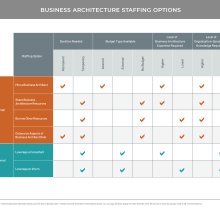Here we go for another round in the “How To Deal” series. In this post, we will be StraightTalkin’ about how to get creative with some tricky business architecture resource challenges. If you’re working on an established business architecture team, this might be just-in-time advice you need. If you are part of a new business architecture practice, you’ll have these ideas in your back pocket in case you need them in the future.
What common challenges do business architecture teams experience related to resources?
Business architecture understanding and buy-in is probably the number one challenge that teams have today, but as it pertains to resources, some of the top challenges are:
- Defining the business architect role (and career path) correctly and effectively
- Designing the most effective organizational structure for the business architecture team and positioning it to succeed
- Obtaining enough business architecture resources to meet the organization’s needs (and not overworking the team)
- Finding, training and mentoring resources to become skilled and experienced at a senior business architect level, with the ability to contribute from a strategic and transformational perspective
- Creating true integration and adoption of the business architect role within the organization
We’ll cover some specific, advanced resource challenges now, but there are loads of answers to other challenges like those stated above in some of our previous StraightTalk posts. Here are a few good ones in case you missed them: No. 6 on the business architect role, No. 7 on building the business architecture team and No. 8 for organizing for success.
Our organization just does not have enough business architects to meet the demand and we will not have the funding to hire new people in the near future. What should we do?
This is a good problem to have. Time to get creative with staffing. Here are a few ideas to get you thinking:
- Share business architecture resources – If you have many business architects within your organization, but some are just busier than others at certain times, jump in and help each other. (Don’t let organizational boundaries stop you.) The area that needs help will get it and the business architect who fills in will get new experiences and exposure. Win-win.
- Borrow other resources from within the organization – Create a program to offer short-term, full-time (or part-time) business architecture opportunities to people in your organization. These opportunities can be valuable to those who are aspiring to the role (e.g. business analysts) or to others who would like the exposure and experience (e.g. a business person who wants to increase their problem-solving skills or a technology person who wants to learn about the business). More win-win.
- Leverage a business architect intern(s) (paid or unpaid) – This can be a great way to develop others (who could potentially work for you someday) as well as get some extra help. Be realistic about what your intern can do, but they can minimally offload a lot of basic work so that the business architects can focus on higher value activities.
- Outsource aspects of the business architect role to other people – Make it easy for others to use the business architecture where possible (e.g. for impact assessment or heatmapping). You can provide guidelines and indicate when a business architect should be engaged.
- Leverage a consultant – Enlist some outside help during surge times. Sometimes this can be easier than hiring a new team member internally, especially if consulting can be obtained from a different budget than headcount.
Check out the handy diagram below to help you identify which staffing option is best for your situation.
In some cases, we do not have the right people in the business architect role. How do we handle a situation like this?
This happens for various reasons. An organization’s understanding of the business architect role can evolve over time (and the industry itself has evolved), so sometimes the original role definition may have been too low level or incorrectly scoped. Or, perhaps you needed to compromise by putting a great hire into a higher level than they were actually performing at in order to meet their compensation requirements. No worries. It’s a journey, so take comfort knowing that and take the opportunity to course correct now.
The first step is to make sure that your business architect role(s) and any levels within that role are correctly defined. (BTW, see The Business Architecture Team white paper for ideas on role, level and competency definition.)
Next, assess the people you have in the business architect role against the revised role definitions. Remember that if someone does not fit, it’s not a judgment of worth, but rather about the best match for their skills and experience—and they will likely be happier and perform better in a different role anyway.
Then the hard part. Have the tough conversations to transition people out of the business architect role and into a new one, and transition new people into the business architect role where applicable. Communication, honesty and care are extremely important.
Keep in mind that the people who are in the business architect role, how they behave, and what they do will speak volumes to the organization about what a business architect really is (and is not). It may take some time for the full change to be made, but in the end, it will be the best outcome for all of the individuals involved as well as the organization.
We have a business architecture team, but when our organization hires consultants we seem to get undermined. How do we stay engaged?
First, start with education. That includes educating your organization (including the leaders who are bringing in the consultants) as well as the consultants themselves when they arrive. Everyone should understand the role and value of the business architecture team within the organization, what knowledgebase assets can be leveraged (e.g. capability map, value streams and cross-mappings to other domains), and when to engage business architects. Make sure everyone understands the bigger picture here too: leveraging the internal business architecture team not only ensures that knowledge stays within the organization but also saves time and money because the consultants do not need to spend time learning or documenting the current environment.
Next, when your organization creates a Request For Proposal (RFP), include language that the consultant or vendor will be expected to leverage the organization’s existing business architecture where applicable versus using their own frameworks. This is a best practice that a number of organizations have used and it works.
Finally, when the consultants arrive, build a partnership from the beginning and communicate some rules of engagement so that you have something concrete to point to. For example, you could draw some clear lines on what types of content they should leverage from the business architecture team versus create on their own.
These proactive steps will ensure that the business architects keep a seat at the table while ensuring that the organization is best served in the end.
Closing Thoughts: It’s easy (and fun) to get focused on the business architecture itself, but the most important investment is in the people. After all, it is the business architects who will create the value from this discipline and use it to transform organizations. In the wise words of Peter Drucker, “The organization is, above all, social. It is people.”
More Good Stuff…
The Business Architecture Team (S2E white paper): Just in case you missed it, this white paper provides comprehensive guidance and addresses many of the top questions related to establishing a successful business architecture team.
The Pygmalion Effect: Proving Them Right (Farnam Street): One of our favorites. Believe the best in people and they will deliver.
Leading With Inner Agility (McKinsey): Five personal practices that will allow you to meaningfully contribute to the mindset needed during transformative times.
5 Ways to Lead in an Era of Constant Change (TED Talk): A highly relevant TED Talk by Jim Hemerling on the necessary imperatives to put people first in this era of “always-on” transformation.

